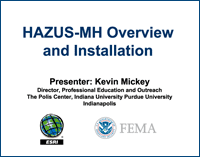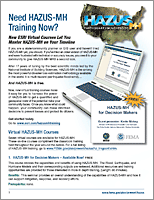New Virtual Courses Let You Master HAZUS-MH on Your Timeline
- Listen to the Podcast about the HAZUS-MH ESRI Virtual Classroom Courses
- HAZUS-MH for Decision Makers -- FREE
- HAZUS-MH Overview and Installation -- FREE
- Introduction to Using HAZUS-MH to Assess Losses from a Riverine Flood Hazard
- HAZUS-MH Flood Model Output and Applications
- Integrating User Supplied Hazard Data into the HAZUS-MH Flood Model
- Introduction to Using HAZUS-MH for Hurricane Loss Estimation
- Introduction to Using HAZUS-MH for Earthquake Loss Estimation
If you are a state/community planner or GIS user and haven't tried HAZUS-MH yet, you should. If you've tried an older version of HAZUS-MH and were frustrated with technical or accuracy issues, you owe it to your community to give HAZUS-MH MR3 a second look.
After 17 years of tuning by the best scientific minds led by the National Institute of Building Sciences, HAZUS-MH is the among the most powerful disaster loss estimation methodology available in the world. It is multi-hazard (earthquake-flood-wind).
And HAZUS-MH is free.
Now, new virtual training courses make it easy for you to harness the power of HAZUS-MH to get a quantified and geospatial view of the potential risks your community faces. Once you know what could happen, your community can make informed decisions to prevent losses and protect its citizens.
Get started today. Go to: www.esri.com/hazusmhtraining
ESRI Virtual HAZUS-MH Courses
Seven virtual courses are available for HAZUS-MH. These on-line courses compliment the classroom training held throughout the year around the nation at the Emergency Management Institute (EMI). View the schedule and full listing of HAZUS-MH training courses available at EMI..
Listen to the Podcast about the HAZUS-MH ESRI Virtual Classroom Courses
Vince Brown, Senior Program Specialist in the Mitigation Division at FEMA, and Kevin Mickey, Director of Professional Education and Outreach at The Polis Center, Indiana University, Indianapolis discuss how the HAZUS-MH web-based courses help public and private organizations plan for and mitigate natural disasters. The speakers also provide an overview of the courses as well as identify ideal candidates for the courses and how these participants will benefit from the training.
Listen/Download the HAZUS-MH Web Course Series Helps Mitigate Natural Disaster podcast.
HAZUS-MH for Decision Makers -- FREE
This course reviews the capabilities and benefits of using HAZUS-MH. The Flood, Earthquake, and Hurricane Models and their corresponding outputs are reviewed. Additional resources and training opportunities are provided for those interested in more in depth training. (Length: 80 minutes).
Benefits: This seminar provides an overall understanding of the capabilities of HAZUS-MH and how it can support mitigation, response, and recovery efforts. Prerequisites: none. Click here for the course.
HAZUS-MH Overview and Installation -- FREE

Users get an overview of the capabilities of HAZUS-MH, FEMA's loss estimation tool for earthquake, flood, and hurricane wind hazards. Learn to install the HAZUS-MH software and define a study region (the area of analysis used by HAZUS-MH). (Length: approximately 2 hours)
Benefit: Explore the basic types of analysis that HAZUS-MH can perform as well as the types of information about the social and economic impacts of natural hazards that it can generate. Prerequisite: "HAZUS-MH for Decision Makers" web course. Click here for the course.
Introduction to Using HAZUS-MH to Assess Losses from a Riverine Flood Hazard
This web course explains the process of defining a riverine flood hazard and performing a loss estimation using HAZUS-MH. While HAZUS-MH offers a wide range of options for defining a flood hazard, this module focuses on the two options that require the least amount of user input defining a flood hazard based on a return period and defining a flood hazard based on a stream discharge. (Length: approximately 2 hours)
Benefit: An easy way for users to obtain an understanding of the potential social and economic impacts that might occur as a result of flooding. Prerequisite: none. Click here for the course.
HAZUS-MH Flood Model Output and Applications
Users will learn about the types of output that the HAZUS-MH flood model generates about the social and economic impacts of flood events. Loss estimations are based upon impacts to the built environment and to the populations that live in the communities impacted by flooding. Obtain estimates of damages to buildings and their contents, losses to essential facilities, impacts on transportation and utility lifelines, and impacts on agriculture. HAZUS-MH also calculates debris generation and shelter requirements. (Length: approximately 2 hours).
Benefit: This module provides an overview of the many types of output that the flood model can generate with a focus on how this information can be effectively used by communities to better plan for and prevent losses from flood events. Prerequisite: "Introduction to Using HAZUS-MH to Assess Losses from a Riverine Flood Hazard" web course recommended.
Integrating User Supplied Hazard Data into the HAZUS-MH Flood Model
Shows users how to integrate hazard data developed in sophisticated flood engineering models into HAZUS-MH for the purpose of performing a more precise flood loss estimation study than is typically possible in a basic HAZUS-MH analysis. This module addresses two of the options for integrating flood hazard data created in other modeling applications into a HAZUS-MH flood study: Option 1: User provides a user-defined flood boundary, digital elevation model, and information about a flood surface; and Option 2: User provides only a flood depth grid in an ESRI Grid format. (Length: approximately 2 hours).
Benefit: Enables a scientifically-based loss estimation to be generated on flood hazard data created in other models. This is especially important to those individuals who plan to use HAZUS-MH to support flood insurance studies or community planning goals. Products generated by programs such as the FEMA Map Modernization Program give communities across the United States the inputs required to use the options noted above. The module includes an exercise that explores these techniques and prepares users to conduct these types of flood loss estimation studies within their own communities. Prerequisite: Familiarity with HAZUS-MH Flood Model.
Introduction to Using HAZUS-MH for Hurricane Loss Estimation
The HAZUS-MH Hurricane model makes use of an existing state-of-the-art windfield model to assess the losses that might be experienced from a hurricane. The hurricane model has the capability to assess impacts from historic storms as well as user defined storms. It can also consider the impact of storms based on their probability of occurring. (Length: approximately 2 hours).
Benefit: Those who complete this module will be able to use HAZUS-MH to generate estimates of building damage, shelter needs, and economic impacts from hurricane wind events. The module will conclude with a hands-on exercise that includes defining a hurricane scenario and reviewing its social and economic impacts. Prerequisite: "HAZUS-MH Overview and Installation" web course.
Introduction to Using HAZUS-MH for Earthquake Loss Estimation
The HAZUS-MH Earthquake model considers information about building stock, economic data, geology, the location and size of potential earthquakes, and other information to estimate losses that might be incurred from an earthquake. This course will conclude with a hands-on exercise which includes definition of an earthquake scenario and a review of its social and economic impacts. (Length: approximately 2 hours).
Benefit: Once the location and size of a hypothetical earthquake are identified, the model estimates the violence of the ground shaking, the number of buildings damaged, the number of casualties, the amount of damage to transportation systems, disruption to the electrical and water utilities, the number of people displaced from their homes, estimated cost of repairing projected damage, and other effects. Prerequisite: "HAZUS-MH Overview and Installation" web course.

HAZUS-MH ESRI Virtual Training Handout
nbsp; This handout provides an overview of the courses and their objectives as well as the ideal candidates for them and how participants will benefit from the training. Links to the courses are provided.
Download Plug-in
Some of the links on this page require a plug-in to view them. Links to the plug-ins are available below.
Last Modified: Wednesday, 02-Jul-2008 16:31:03 EDT
